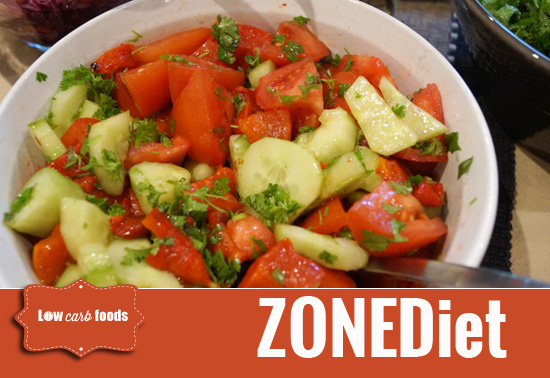Zone Diet
The Zone Diet is a diet plan based on the 40:30:30 ratio of daily calories coming respectively from carbohydrates (carbs), proteins, and fats.
The Zone Diet was created by Dr. Barry Sears, a biochemist. Sears recommends a moderate, as he himself calls it, diet of one gram of fat for every two grams of protein and three grams of carbohydrates. The aim of this Zone 1-2-3 method (carbs 40%, fat 30%, and proteins 30%) is to balance the body's hormones and to control hunger and food cravings. The ratio is designed to improve metabolism and help maintain stable blood sugar levels. Sears claims that high insulin levels are responsible for weight gain, and it is important to consume products from different food groups in the right proportions. High insulin levels cause inflammation which is the main reason for weight gain and obesity. The only downside is the tedious portioning which may cause boredom. The diet promotes low-fat protein, low-glycemic carbs, such as most fruits and vegetables, together with regular exercise. In later publications, the plan introduced the consumption of a specific ratio of Omega-3 to Omega-6 fatty acids, with the popularity of the pharmaceutical Omega 3 fish oils being largely attributed to Dr. Sears.

Daily Routine
The fact that each meal must contain the right percentage of fat, protein, and carbohydrate makes this diet a bit tedious. Sears also recommends a strict eating schedule with meals and snacks consumed every couple of hours. The total daily blocks depend on your body type, i.e. medium female, small female, athletic male, X-large male, etc. One block is equal to 1.5 grams of fat, 9 grams of carbohydrate, and 7 grams of protein. The good news is that plenty of recipes are available to break your routine and add diversity to your menu. Dining out is also allowed as long as people stay away from starches and bread. Alcohol is allowed in moderation.
As Sears says, the term "The Zone" refers to the maintenance of proper hormonal balance between three major hormones generated by the body - insulin, glucagons, and eicosanoids.
The theory behind the Zone Diet is that a high intake of carbs entering the bloodstream produces too much insulin - the "storage" hormone that tells the body to stock on fats, making people overweight. To the contrary, protein increases the levels of glucagon - the hormone that makes the body steadily release the stored carbs, making the individual feel full, and controlling the appetite. The carbs' release turns stored fat into fuel, leading to weight loss. The eicosanoids hormones control the entire inflammatory process and indirectly influence many of the body's hormonal systems.
Barry Sears published his first book The Zone: A Dietary Road Map in 1995, followed by Mastering the Zone, The Anti-Aging Zone, A Week in the Zone: A Quick Course in the Healthiest Diet for You, The Soy Zone. Sears, The Omega Rx Zone: The Miracle of the New High-Dose Fish Oil, The Anti-Inflammation Zone: Reversing the Silent Epidemic That's Destroying Our Health.
The Zone Diet enjoys huge popularity exactly because of its moderation and the promotion of balanced meals without banning any food, even snacks. Along with millions of dieters, Hollywood and other celebrities such as Jennifer Aniston, Renee Zellweger, Cindy Crawford, Charlie Sheen, Tom Cruise, Sandra Bullock, Demi Moore, Sarah Jessica Parker and Tiger Woods, among others, are said to have followed the Zone Diet.
While the Zone Diet is often listed as a low-carb diet, it is not as restrictive as some others, particularly the very popular 2000s Atkins Nutritional Approach of Robert Atkins, which promotes high intake of saturated fats and very few carbs. Dr. Sears himself has been a critic of the low-carb plans because he believes they overlook the importance of hormonal balance and moderation. The Zone, unlike other carb-restrictive diets, requires counting calories as to not exceed 500 calories per meal.
The balanced ratio has been subject to debates, but still very few scientific research is available. A PBS documentary revealed favorable results while the most successful listed "Zone" weight loss is 184 kg for the Mexican Manuel Uribe, who in two years went from 560 kg down to 366 kg.
Health Benefits
There are plenty of benefits, one being that people are encouraged to consume foods high in fiber, calcium, potassium, vitamin D, vitamin B 12, and other essential nutrients. Some studies also suggest that the diet helps improve cholesterol levels and reduces the risk for cardiovascular problems. Some proponents also emphasize the fact that healthy eating helps control and prevent diabetes. It promotes steady weight loss to reduce the risk for type 2 diabetes. Unlike fad diets, this plan is far from being extreme and promotes regular exercise. In addition to health benefits, people enjoy free access to videos, podcasts, recipes, body fat calculators, and other tools. The Zone can be customized and adjusted to fit a low-salt, gluten-free, vegan, vegetarian, or kosher menu.
Criticism
Most criticism involves the allowance of ample amounts of meats with saturated fats, the elimination of vegetarian meals and vegetables from the plan, while others claim Sears' theory has not been scientifically proven.
